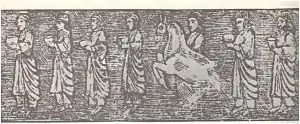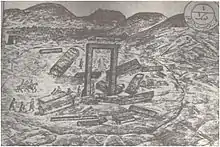Asar-e Ajam
Āsār-e Ajam[notelist 1] (Persian: آثار عجم, pronounced [ɒːsɒːre ædʒæm], lit. "Antiquities of the Persians")[1] is a travelogue and historical book written by Forsat Shirazi between 1881 and 1895 which mostly contains first-hand biographical information about the elite of Fārs, sources on the history of the region as well as its geography. It also involves a collection of more than fifty drawings of various historical sites of Persia, especially Fārs. It is an important book because of accurate renditions with Qajar style—of the reliefs and buildings at Persepolis.[2][3]

Onomastics

The title of the book "Asar-e Ajam" is an Arabic phrase which consists of two nouns; Asar (in Perso-Arabic alphabet: آثار) (or Athar in its original Arabic pronunciation) which means deeds, antiquities or monuments and Ajam (in Perso-Arabic alphabet: عجم) which in Arabic literature refers to the Persians.
Documentary
In 2016 Iranian documentary director Hassan Naghashi made a film named Asar-e Ajam which mainly dealt with the life of Forsat-od Dowla and most specifically the structure of the book and its publication.[4]
Notes
- Also transliterated as Ātār-e Ajam, Āthār-e Ajam, and Asar-i Ajam
References
- Giovacchini, David. "A Nineteenth Century Vision of Persia's Past". Unique at Penn. Penn University. Retrieved 13 October 2017.
- LERNER, JUDITH A. "A Dialogue with the Past". INSTITUTE FOR THE STUDY OF THE ANCIENT WORLD. New York University website. Retrieved 13 October 2017.
- Kasheff, Manouchehr. "FORṢAT-AL-DAWLA". Encyclopedia Iranica. Iranica online. Retrieved October 13, 2017.
- "معرفی فرصتالدوله شیرازی با یک مستند/ شخصیتی صادق ارایه شد". Mehrnews. Retrieved 13 October 2017.